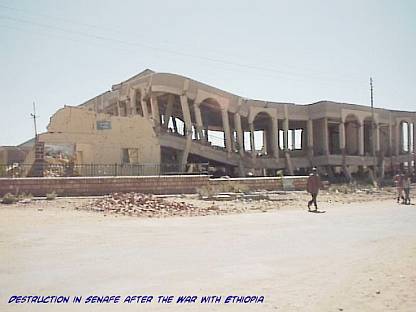Surveying Eritrea's devastation
.
Surveying Eritrea's devastation
By Peter
Biles
BBC correspondent in Asmara
I've experienced a few extremes of temperature and climate over the years, but nothing quite like Bada. It lies in the Danakil Depression in eastern Eritrea inland from the Red Sea and 70 metres below sea level.
At times, it's the hottest place on Earth. They say the temperature can reach a life-threatening 68C.
It's here on the border between Eritrea and Ethiopia, that the United Nations now has 4,000 peacekeepers, in what they call a Temporary Security Zone - 25 kilometres wide - designed to ensure that the armies of Eritrea and Ethiopia are kept apart.
We arrive in a UN helicopter. It's an old Russian-built Mi8, crewed by pilots from Kazakhstan. The peacekeepers waiting on the ground at Bada are Indian - they're from the 27th Battalion - the Rajput Regiment.
The helicopter is loaded with their supplies of food. Bada is so remote that everything, including fruit and vegetables, is flown in.
It's 0930 as we touch down in a dry river bed close to the Indian camp. The temperature is a modest 39C, but set to soar during the day.
With all the military precision that you'd expect, an Indian soldier is on hand to offer a cooling drink, made with mint and coriander.
There are other Indian delicacies, served on a silver platter. But our time here is short. We have just half an hour to watch the Indian peacekeepers out on foot patrol.
In spite of the heat, they wear body armour and their blue UN helmets, as they move through a nearby settlement belonging to the nomadic Afar population who live in this region.
These patrols only take place before 1100. After that, the peacekeepers return to their air-conditioned portakabins.
Border delays
The aim of the patrols is simply to demonstrate the UN's presence on this border - the scene of such intense fighting between Eritrea and Ethiopia until three years ago.
What both countries are waiting for, is the official demarcation of the border. It was hoped a start would have been made by now in erecting the pillars along this barren frontier stretching 1,000 km from Sudan in the west to Djibouti in the east.
But there's a hitch. For the moment, Ethiopia won't accept the ruling of the independent Boundary Commission that Badme - a one-horse town without the horse - actually lies within Eritrea.
It was in Badme that the war began in 1998. It started as a skirmish, and developed into a conflict that cost at least 60,000 lives in two years.
But amid the current uncertainty, Eritrea is refusing to demobilise around 250,000 soldiers.
There's no sign of them of course, in the UN's demilitarised zone. There are Jordanian peacekeepers in charge in the western sector, the Indians in the centre, and the Kenyans in the east.
The Indians - who know a thing or two about lines of control - are involved in far more than just basic peacekeeping. They run computer classes for local Eritreans, conduct Aids awareness programmes and provide medical aid.
'Confidence building'
An Indian woman doctor serving with the battalion has made great strides in learning the local language, Tigrinya, in the few months she's been here.
It all
adds to the confidence-building among people whose lives have been turned
upside down.
.
 |
In one of the main towns close to the border - Senafe - there is some semblance of normality. A convoy of UN vehicles is forced to pull off the main road to make way for a cycle race. It's a popular sport in Eritrea, and hundreds of people have turned out to cheer on a group of cyclists, as they sprint backwards and forwards through the town centre. But looking around Senafe, this is not the town it once was. The hospital and the telecommunications centre are little more than piles of rubble, deliberately blown up by the Ethiopian occupying forces three years ago, according to the Eritreans. Most of the patients have to be treated in tents in the grounds of the hospital. The local doctor, Berekat Brahane, has help from a Cuban medic - but there's far more than they can handle.. |
.
They're the only two doctors in
Senafe, with its population of more than 20,000
Over dinner that evening, Dr Berekat reflects wistfully about the time when he trained as a doctor, across the border in the ancient Ethiopian town of Gondar.
He looks forward to the day when relations between the two countries can be restored - but that still seems a long way off.
Refugees in limbo
If life is tough for the people of Senafe, spare a thought for the Eritreans on the border who are still living in tented camps, three years after the war ended.
They're stuck there, either because their homes have been destroyed, their fields have been mined or because they're not yet sure on which side of the border their villages will lie, once demarcation is complete.
The latest drought is making conditions even harder, but occasionally, there are small rays of hope.
The International Committee of the Red Cross has just introduced a new type of wood-fired oven for cooking the traditional injera - this is rather like a large spongy pancake.
The design of the new ovens means they use 50% less wood. It's a big help to people who often have to walk long distances to gather firewood.
At a UN observation post overlooking the border, an Indian commander shows me his maps. The mountains of Ethiopia are just across the stream in the valley below.
The scenery is rugged and breathtaking, but it's the maps and the demarcation line that demand our attention. This isn't glamorous work for the UN peacekeepers, but it is vital to the future stability of both Eritrea and Ethiopia.
Nothing could be more important.